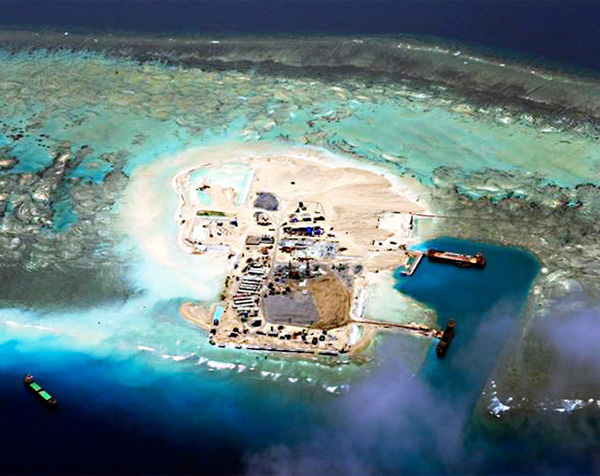|
Artificial islands: 'military fortresses' or
'sandcastles'?
Building up rocky
areas, changing reefs into islands, and building runways and infrastructure
on illegally occupied islands are part of
Dr. Truong Minh Huy Vu, from the
Faculty of International Relations of the

A vessel looks like a container ship in the area
where
China's
acceleration of turning reefs in Vietnam’s Truong Sa Archipelago (
With an area of up to 3.5 million
km2, a relatively enclosed waters, military experts have long discussed
One is directly through control and
construction of islands/reefs into military bases and two is establishment of
air-defence recognition areas limited in certain geographic scopes. To
realize these two possibilities, the Chinese army needs the strategic points.
In Vietnam’s Hoang Sa (Paracel
Islands) and Truong Sa, the geographical subjects are mainly reefs and coral
islands that do not have advantage in terms of defense or are in a severe
shortage of fresh water, except for Thai Binh Island (Itu Aba) under control
of Taiwan. So joining the sea from the mainland, and turning reefs into
fulcrums to promote the resistance to access or intrusion (A2/AD) is always a
priority of
In Hoang Sa, which
It is more difficult in Truong Sa
because of the distance and the limitations of technology. For example, the
refueling capability of the Chinese air force is still limited. This
technology is important in the implementation of A2/AD, because it helps
According to a report by the
Committee for US-China Economic and Security Review (published last December),
The report also said that the team of
tanker planes of
So the fostering
and building of artificial islands in Truong Sa is the best way to compensate
for the limitations of geography and technology in the present time?
We need a bigger picture of the link
between the Navy and the Air Force as a new approach to the "standing
position" of the Chinese military in the entire
Recent studies have described the
trend of the Chinese People's Liberation Army (PLA) in trying to promote the
so-called "coordination skill" between the various military arms,
especially the air force and navy.
The quadrangle of "artificial
islands," formed from the reefs of Chu Thap (Cross Fiery), Vanh Khan
(Mischief), Hoang Nham (Scarborough) and
However, there are many doubts about
the possibility of "successful upgrading" of artificial islands
into complete military fortresses. The goal of setting a "terrestrial
military carrier" in the islands which have been extended and leveled is
an example. Bad weather such as storms or the ability of salt eroding the
runway are problems for the deployment of air operations.
But more importantly, the structure
of airports is based on the dredging of tons of sand in the seabed. It is not
stable in terms of texture, and it may be the "dead" point for air
strikes and missile. Two scholars from the US Naval War College said that
these "airports" can only be "sand castles" and instead
of finding bottlenecks to overcome the strategic losses, then this is the
"new strategic vulnerability" of
According to this
analysis, turning artificial islands into "bases" as the
springboard to control the entire
Perhaps we are talking about two
issues in parallel, but also contradictory. One is to assess the military
ability of artificial islands as a springboard of
These assessments emphasize the
military aspect, but mention the possibility in the future, and do not
mention much about the current difficulties that
The second view is about the
limitation (military) of
The presence and military
intervention of the
Conversely, if the "artificial
islands" are seen as a next step in
"Presence" in the
geographical sense is just equivalent to distance, and a sense of possibility
to intervene. Military impact (of artificial islands) may be the future, but
its psychological impact is right now, from support to marine surveillance
vessels, expansion of fishing grounds, oil and gas exploration and
exploitation, and ocean science research, as well as prevention of the
assertion of sovereignty or jurisdiction enforcement of other countries.
In addition, negotiations on the Code
of Conduct in the
Minh Cat, VNN
|
Thứ Bảy, 18 tháng 4, 2015
Đăng ký:
Đăng Nhận xét (Atom)
Không có nhận xét nào:
Đăng nhận xét